Content [show]
Thanks to the efforts of breeders, tomatoes can be grown on the windowsill, and at any time of the year. There are many varieties that can produce good yields indoors. Growing them is no more difficult than ordinary tomatoes in the garden, moreover, they are not afraid of either drought or the Colorado potato beetle. To enjoy fresh tomatoes in the winter cold, you need to study all the nuances of such cultivation, but the most important thing is to choose the right variety.
Tomatoes on the windowsill in winter
Features of indoor tomatoes
Indoor conditions differ significantly from those in the garden, so not every variety of tomatoes will be able to grow and bear fruit normally indoors. Varieties for growing on a windowsill have the following characteristics:
- short stature. Due to the limited space, only undersized and dwarf tomatoes are able to form a crop. Tall tomatoes require not only a lot of space, but also a large amount of nutrients, and there is too little soil in the flower pot for this;
- stamina. Not everyone knows how to form a bush correctly, but this is an important condition for the yield of a tomato. Standard varieties have a strong central stem and a dense crown; it does not need to be pinned or tied up;
- resistance to lack of lighting and disease. Indoor plants receive less light, especially in winter, and therefore really need additional lighting. But there are varieties of tomatoes that bear fruit normally in a short day, and they only need backlighting on cloudy days. Their genetic feature is short internodes, due to which the stems do not stretch. Of the diseases, tomatoes are most threatened by black leg (during the period of growing seedlings) and leaf mold. The most resistant to them are hybrids, which make up 90% of the total number of potted tomatoes.
Cherry tomatoes on the windowsill
In addition to these features, indoor tomatoes are distinguished by the highest taste qualities, and are rightfully considered the champions among tomatoes in terms of the content of vitamins and sugars in the pulp. But not all of them can boast of productivity, because some varieties are more decorative, and form very small, cherry-sized fruits. Of course, they are also edible, but there are too few of them, and therefore they are most often used to decorate dishes.
Indoor tomatoes
If you need tomatoes for daily consumption, choose large-fruit varieties that are high-yielding.As a rule, the mass of indoor tomatoes varies between 15-130 g, depending on the variety. The best of them form low bushes completely covered with fruits. On average, one bush can produce up to 2 kg of tasty, marketable tomatoes per season.
Potted tomatoes have one more feature - they are perennials. If, after collecting the last fruits, the bush is not thrown away, then after a while new leaves will appear on the stem. Usually such tomatoes grow and bear fruit within 5 years, although the most abundant harvests are given in the first 2 years.
Growing tomatoes on a windowsill
The best varieties of indoor tomatoes
The assortment of indoor tomatoes is smaller than usual, but also impressive. Varieties differ in shape, size and color of fruits, height and shape of the bush, ripening time and other parameters. Every year, new varieties and hybrids from leading breeding companies are added to their list. Below are the most popular windowsill tomatoes.
|
Balcony miracle |
This early ripe variety forms standard bushes up to half a meter high. Its fruits are red, round, with a high sugar content. Unlike most potted tomatoes, this variety grows up to 70-100 g. With good care, the yield per plant is about 2 kg. The balcony miracle adapts well to a lack of light and can bear fruit perfectly in winter |
|
Room surprise |
Early ripening, standard. The height of the bushes does not exceed half a meter, and the weight of bright red elongated fruits, collected in bunches, is equal to 25-30 g. The pulp of these tomatoes is very tasty and aromatic, they are great for salads. In winter, the plant needs lighting, otherwise the harvest will be rather weak. |
|
Bonsai |
A neat lush bush up to 30 cm high.Tomatoes of this variety have a rounded shape and rich red color, the weight of the fruit is 25 g. With good care, each plant gives 1 kg of tasty commercial tomatoes per season |
|
Micron NK |
Today it is considered the smallest type of tomato, the height of its bushes is only 12-15 cm. Round, small fruits (10-12 g) are yellow and red. You should not expect a large harvest from it, but in terms of decorativeness, the variety is ahead of most potted tomatoes. Ideal for winter growing, as it does not depend on the length of daylight hours |
|
Pinocchio |
One of the best potted varieties. Plants are not tall, maximum 30 cm, densely leafy, compact. Fruit weight - about 20 g, red color. One bush yields from 1 to 1.5 kg of tomatoes, which are suitable not only for salads, but also for canning. In the summer, it can be grown in the beds, and in the fall, the bushes are transplanted into pots and brought into the house. |
|
Pygmy |
Its fruits ripen 85-90 days after germination. Standard variety, universal use, bears fruit well in a short day. His tomatoes are small, weighing 25 g, red, fragrant. The bush itself looks very decorative during the ripening period. |
|
Florida Petite |
A popular variety appreciated for its high yield. The bushes are compact, do not exceed 30 cm in height, do not need pinching. Its fruits are small (20-40 g), red in color, with very sweet pulp. The ovaries are collected in long clusters, and during the ripening period of the leaves is almost invisible under the fruits. The variety is resistant to low light and bears fruit well in winter. |
|
Bunch of honey |
Yellow-fruited and early ripening variety. Can be grown both on the windowsill and in the open field. The height of the standard bushes does not exceed 40 cm, the crown is dense, does not need to be formed. Tomatoes weigh about 40 g, the yield is very high. The peel of the fruit is thin, orange in color, the pulp is sweet and juicy |
|
Window yellow |
A new, still rare variety. The plant is a standard plant, 25 cm tall, during the fruiting period the entire bush is covered with clusters of yellow small round tomatoes. Fruit weight rarely exceeds 30 g, the pulp is very sweet.The variety is neutral to low light, therefore it bears fruit well in winter. |
|
Teeny Tim |
Early ripening popular Dutch variety. Bears fruit regardless of the season and the degree of lighting. The height of the bushes is about 30 cm, in the open field it can grow up to 50 cm.The weight of the tomatoes is 12-14 g, the color is red, the pulp is moderately sweet |
Ampel varieties
In addition to standard varieties, ampel tomatoes are also in demand among fans of indoor tomato cultivation. They can be planted in hanging pots or in tall pots, from which the shoots will hang beautifully on the windowsill. Caring for them is a little more difficult than for ordinary varieties, and the yield is lower, but all this is offset by the excellent taste of tomatoes and the high decorative effect of the bush. The choice of ampel varieties is still small, and seeds can be purchased only from a few domestic agricultural firms.
|
Garden Pearl |
A spreading bush with shoots up to 50 cm. The plant's stems are thin, but strong, and do not break under the weight of numerous fruits. You do not need to walk the bush. Round tomatoes weighing 15-20 g, when ripe, acquire a raspberry color and become translucent. One plant can have up to three hundred fruits of a presentation. The variety is very decorative, feels great indoors and outdoors |
|
F1 Citizen |
Spectacular early maturing hybrid. It can grow vertically (but then it is necessary to tie up the stems) and as an ampelous plant. His tomatoes are round, red, with a characteristic tomato flavor, weighing about 30 g. The hybrid is specially bred for indoor cultivation, therefore it develops well and bears fruit regardless of the season |
|
Cherry Fingers F1 |
New yielding hybrid for ampel cultivation. Low-leafed shoots, up to half a meter long, strong. Small red fruits have an elongated shape, are attached to long clusters of 8-10 pieces. Tomatoes are suitable for harvesting for the winter; they do not crack during heat treatment. In good conditions, the yield of one bush is 1.8-2 kg |
|
Toggle switch |
One of the new ampelous varieties. Very early, has a cascading bush shape, the mass of tomatoes is 25-30 g. The taste of the fruits is excellent, the average yield is about 2 kg. With a lack of lighting, the number of fruits is slightly less |
|
Mascot |
Already a fairly well-known ampelous variety of domestic selection. Refers to medium early, the bush is quite compact, shoots up to 55 cm long. Egg-shaped fruits of red color, average weight about 40 g. When grown in open ground, the mass of fruits is almost twice as large. The variety is distinguished by extended fruiting, and very abundant. Tomatoes are juicy, tasty, can be preserved |
|
Red Abundance F1 |
A very attractive fruitful hybrid. Shoots grow up to 60 cm, the plant does not need pinching. The brushes are densely hung with small (20g) sweet red fruits, which are suitable for canning. The bush grows quickly, so it needs a lot of space. In winter, the plant must be highlighted, otherwise the yield will decrease |
Agricultural technology for growing indoor tomatoes
As with regular varieties, indoor tomatoes are best grown through seedlings. And at this stage there are no differences, except that the timing of sowing seeds is different. On average, potted tomatoes begin to bear fruit in 90-100 days after germination, and if you want to get the first tomatoes by a certain date, take this factor into account. For example, to harvest the first crop in January, plant the seedlings at the end of September.
Two ways to test seeds for germination
Before sowing, the seeds are disinfected by soaking for 15-30 minutes in a weak solution of potassium permanganate, and then left in a damp cloth for a couple of days to hatch.
Tomato seed preparation
Sow in a common container with ordinary soil or purchased substrate to a depth of no more than 1 cm. The distance between the seeds should be within 2-3 cm so that the seedlings are not thickened.
Capacity for growing tomatoes
Tomatoes in a box
Seedlings are transplanted into separate containers as soon as 2-3 true leaves are formed in the seedlings. The sizes of pots are selected depending on the variety of tomatoes: for dwarf tomatoes, a volume of 1.5-2 liters is enough, for ordinary room ones 3-4 liters, for ampelous ones - at least 5 liters. All pots must have drainage holes. It is very important to properly prepare the soil, because the development and fruiting of the bush depends on its composition.
Soil preparation
The best option is the following composition:
- 5 parts of garden soil;
- 2 pieces of sand;
- 5 parts of rotted compost;
- 1 part peat.
On a bucket of such a mixture, it is necessary to add a matchbox of urea and potassium sulfate, a handful of sifted wood ash. All this is thoroughly mixed. Now you can start planting seedlings.
Step 1... A drainage layer of fine gravel, pieces of bark, expanded clay or other material is poured onto the bottom of the pots. Fill the containers to the top with soil and make a small depression in the center.
Filling the pot with drainage and soil
Step 2. The pre-watered seedlings are carefully removed one at a time and planted in pots, deepening to the cotyledonous leaves. Water gently.
Planting tomato seedlings in a pot
The soil must be saturated with moisture for the water to get to the roots.
Step 3. They put the pots on the windowsill (preferably on the south side) and regularly turn them on the other side to the light every 2 days. In the mornings and evenings, as well as in cloudy weather, plants should be supplemented with a phytolamp.
Supplementary lighting of tomatoes with phytolamp
After a week, the plants are fed with half the nitrogen fertilizer required for growth. During the flowering period, in order to increase the percentage of pollination, the stems of the plant are very lightly shaken and carried over the flowers with a feather or a soft brush. After the formation of ovaries, potash fertilization is required every two weeks.
In varieties that need to form a bush, remove stepchildren, pinch the top of the main stem, cut off excess inflorescences to increase the size of the fruit. Tall bushes are tied to supports, which are stuck into the ground along the edge of the pot.
Tomato care
If signs of fungal infection appear, all plants are sprayed with phytosporin or another anti-fungal agent. To prolong fruiting, regularly pick ripe fruits, remove dried leaves, do not forget about dressing and watering. The soil in pots should be periodically loosened, being careful not to catch the roots. With this care, your tomatoes will delight you with an abundant harvest of sweet, tasty fruits all winter.
Video - Tomatoes on the windowsill in winter: the best varieties
Video - Tomatoes on the windowsill in winter: the best varieties and order of growing tomatoes at home
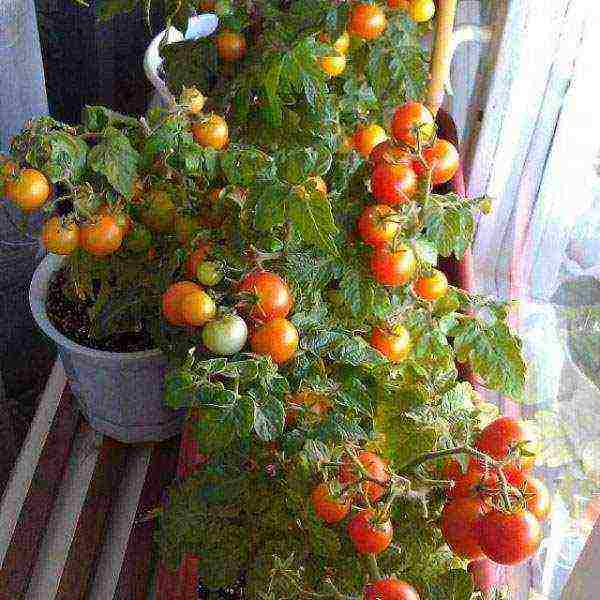 Who among us does not dream of fresh vegetables that can be eaten not only in season? Why go to the supermarket in winter for imported tomatoes that don't even smell like them when you can grow natural tomatoes on the windowsill ?! By moving indoor flowers and freeing up space for several pots, fragrant and tasty tomatoes are easy to get even at home. How to do it correctly, in order to pamper your loved ones with vitamins all year round, will be prompted by a small selection of practical tips and recommendations, which we propose to familiarize yourself with today.
Who among us does not dream of fresh vegetables that can be eaten not only in season? Why go to the supermarket in winter for imported tomatoes that don't even smell like them when you can grow natural tomatoes on the windowsill ?! By moving indoor flowers and freeing up space for several pots, fragrant and tasty tomatoes are easy to get even at home. How to do it correctly, in order to pamper your loved ones with vitamins all year round, will be prompted by a small selection of practical tips and recommendations, which we propose to familiarize yourself with today.
Seed sowing time
The timing of when to start sowing tomato seeds for window sill cultivation does not have such restrictions as in the case of obtaining seedlings for open ground. It all depends on the period for which fruiting is planned: whether it will be a year-round "exploitation", or the maturation of the crop in particular in winter.
In order to have fresh vegetables throughout the year, regardless of the weather, seeds can be planted in 4 passes: autumn sowing in October and November will provide a winter harvest, and planting in February and March will guarantee fruit in the summer.
Preparation of planting material
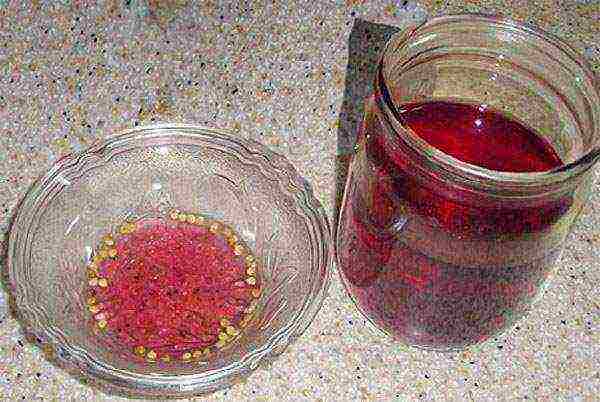 Potted tomatoes are grown in the same way as garden crops - through seedlings. You can use your own seeds, collected with your own hands from homemade tomatoes, or you can buy them in the store. However, regardless of origin, all seeds must first be prepared for sowing. For this:
Potted tomatoes are grown in the same way as garden crops - through seedlings. You can use your own seeds, collected with your own hands from homemade tomatoes, or you can buy them in the store. However, regardless of origin, all seeds must first be prepared for sowing. For this:
- Sort out hollow seeds by soaking everything in salted water (those that come up are not suitable for seedlings).
- Disinfect by leaving for half an hour in a solution of potassium permanganate.
To speed up the germination of seeds, they can be put in a cloth bag, well moistened and left on a platter for several days so that the seeds swell.
Soil selection
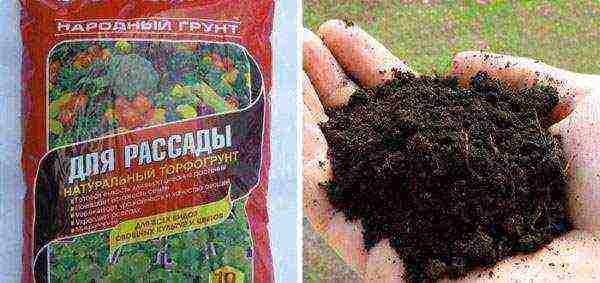 Particular attention should be paid to the substrate for growing tomatoes on the windowsill. It should be loose, nutritious and neutral in acidity. The easiest way is to contact the same store where the seeds were bought and purchase ready-made special soil mixtures for tomato seedlings. This will be especially important during winter sowing, in addition, the store land already contains all the necessary nutrients, and there is no need to add additional components.
Particular attention should be paid to the substrate for growing tomatoes on the windowsill. It should be loose, nutritious and neutral in acidity. The easiest way is to contact the same store where the seeds were bought and purchase ready-made special soil mixtures for tomato seedlings. This will be especially important during winter sowing, in addition, the store land already contains all the necessary nutrients, and there is no need to add additional components.
If there is a desire and opportunity, you can prepare the soil for growing a tomato on a windowsill yourself by choosing one of the proposed mixture options, namely:
- 1 share of sand and 2 shares of garden land;
- humus, peat and sod land in equal shares;
- 1 share of vermiculite, as well as 4 shares of sod land and compost.
The soil from the garden or vegetable garden must be disinfected before use by pouring it with boiling water or igniting it in the oven.
Sowing seeds and creating conditions for seedlings
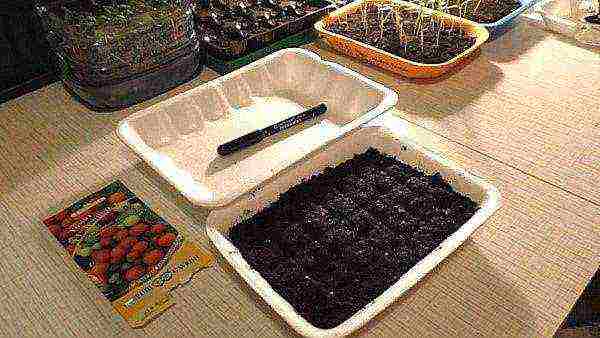 For growing tomato seedlings, you can use both a common container and individual cassettes, cups or peat tablets. In the first case, fill a shallow container with nutritious soil and moisten it well. Seeds should be laid out at some distance from each other (1-2 cm), deepening by no more than 2 cm, otherwise they will germinate for a long time. Then sprinkle with a thin layer of soil and tamp lightly.
For growing tomato seedlings, you can use both a common container and individual cassettes, cups or peat tablets. In the first case, fill a shallow container with nutritious soil and moisten it well. Seeds should be laid out at some distance from each other (1-2 cm), deepening by no more than 2 cm, otherwise they will germinate for a long time. Then sprinkle with a thin layer of soil and tamp lightly.
Seeds should germinate in a greenhouse, that is, the container must be covered with a lid or foil and placed on a bright window. Periodically ventilate the greenhouse or make several small holes in the film to avoid the accumulation of condensate. Optimal temperature conditions for seedlings at this stage of growth are from 22 to 24 degrees Celsius during the day and below 20 degrees at night.
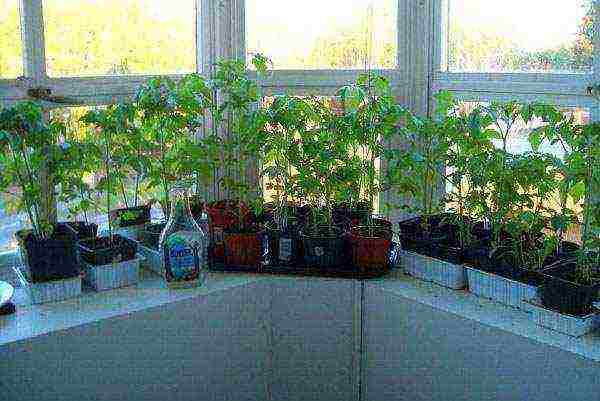 Caring for seedlings of indoor tomatoes consists in the following activities:
Caring for seedlings of indoor tomatoes consists in the following activities:
- airing;
- removing the cover after seed germination;
- regular watering;
- thinning out too dense crops;
- additional lighting with special lamps on cloudy days and shading from direct rays on sunny days (the length of daylight hours should be at least 13 hours);
- feeding with a weak solution of the mineral complex after the formation of 2 leaves (about 20 days after sowing).
Strong grown seedlings can be dived into pots, having previously laid a drainage layer on the bottom. The choice of containers depends on the specific variety:
- for dwarf tomatoes, a volume of 2 liters is enough;
- for medium-sized plants, 4-liter flowerpots are suitable;
- for ampelous varieties of tomatoes, pots with a volume of 5 liters are needed.
Further care for potted tomatoes
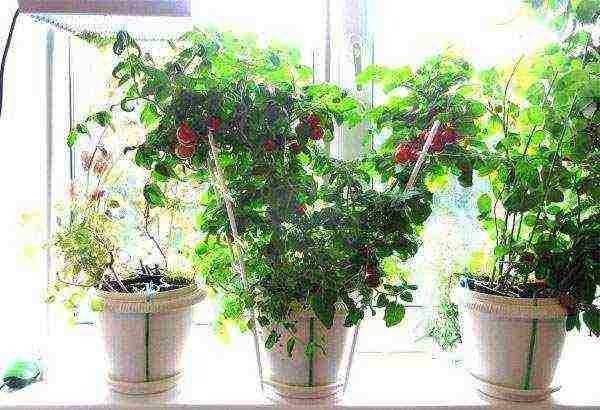 In order for the tomatoes on the windowsill to develop well and set fruits, they need to provide good lighting by placing the pots on the southern windowsills. Every two days, the flowerpots must be turned so that the bushes do not grow one-sided, and if the sun is not enough, they must be illuminated.
In order for the tomatoes on the windowsill to develop well and set fruits, they need to provide good lighting by placing the pots on the southern windowsills. Every two days, the flowerpots must be turned so that the bushes do not grow one-sided, and if the sun is not enough, they must be illuminated.
It is also important to observe the watering regime, moistening the soil twice a week. The soil must not completely dry out, otherwise the ovary and fruits will crumble, but waterlogging also threatens with putrefactive diseases. After transplanting to a permanent place, you can start feeding the bushes after 20 days - during this time they adapt. It is enough to apply 3 times complex mineral fertilizers within a month, otherwise there is a risk that tomatoes will go into the growth of deciduous mass, which will entail a decrease in yield and crushing of fruits.
It is necessary to apply fertilizers on wet soil, preferably the next day after watering.
Dwarf tomato varieties do not need pinching and garter, but in higher species, a support should be installed and a bush should be formed into one or two stems, and stepchildren should be plucked out.
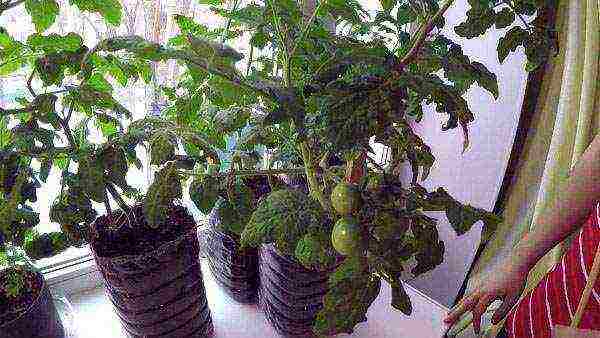 There are some more tricks that will increase the yield of tomatoes, namely:
There are some more tricks that will increase the yield of tomatoes, namely:
- when the bushes are blooming, you need to lightly shake the plants several times - this contributes to better pollination and, accordingly, will affect the amount of the crop;
- if a lot of ovary has formed, no more than 6 brushes should be left on each stem, having poured out the rest - this way you can get fewer tomatoes, but they will be larger;
- in varieties that ripen unevenly, it is better to harvest at the half-ripeness stage - then the bush will have more strength for the tomatoes remaining on the branches, and the plucked vegetables will quickly reach if they are laid out next to the pot on the windowsill.
Protecting tomatoes from disease
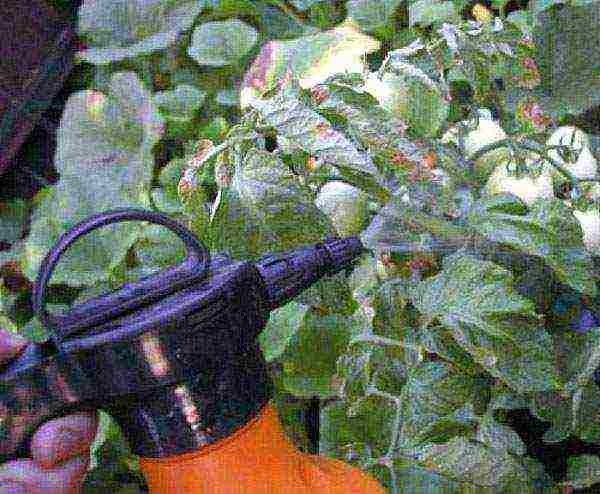 Another point worth paying attention to is the protection of tomatoes in pots from diseases, because even indoor conditions cannot guarantee their complete absence. One of the main enemies of nightshade is late blight. In order to prevent its manifestation, it is important not to fill the bushes and drain the water from the sump. The fungus also does not tolerate fresh air, so it is necessary to ventilate the room more often. As a preventive measure, you can spray the plants with a home remedy prepared from the following components:
Another point worth paying attention to is the protection of tomatoes in pots from diseases, because even indoor conditions cannot guarantee their complete absence. One of the main enemies of nightshade is late blight. In order to prevent its manifestation, it is important not to fill the bushes and drain the water from the sump. The fungus also does not tolerate fresh air, so it is necessary to ventilate the room more often. As a preventive measure, you can spray the plants with a home remedy prepared from the following components:
- 3 liters of water;
- 100 g garlic (minced);
- 1 g of dry crystals of potassium permanganate.
Indoor tomato varieties
When choosing a tomato variety for growing on a windowsill, it is worth giving preference to undersized, early ripening and fruitful species due to the limited space. They will not take up much space and at the same time will delight you with delicious fruits in early spring. Some of the most popular varieties are the following tomatoes:
- Balcony miracle. The height of a dense, even bush is no more than 60 cm. Small, round, bright red and sweet tomatoes ripen 90 days after sowing. The mass of one tomato is not more than 60 g. From one such dwarf, you can take up to 2 kg of fruits.

- Oak. The variety is not hybrid, early ripening, slightly branched, with a bush height of 40 to 60 cm. Rounded tomatoes weighing up to 100 g ripen at the same time, the pulp is fleshy, with a slight sourness. It requires artificial pollination in indoor cultivation, but it has a high resistance to late blight.
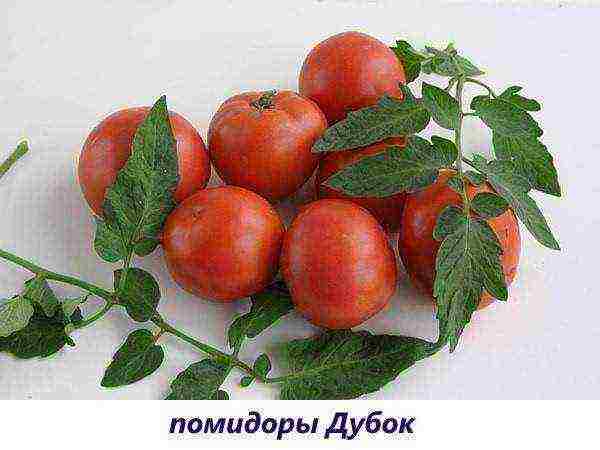
- Ruby Ed. The variety was created specifically for growing on windowsills, balconies and terraces. The bushes are compact, up to 50 cm in height. Small fruits weighing from 20 to 50 g have a sweet taste and rich red color.

- White filling. Bushes up to 70 cm in height grow equally well both in the open field and in a pot. The fruits ripen in 85 days, they are large enough (up to 130 g), rounded, red in color with a slight white tint. The pulp is juicy, with sourness, the skin is dense.
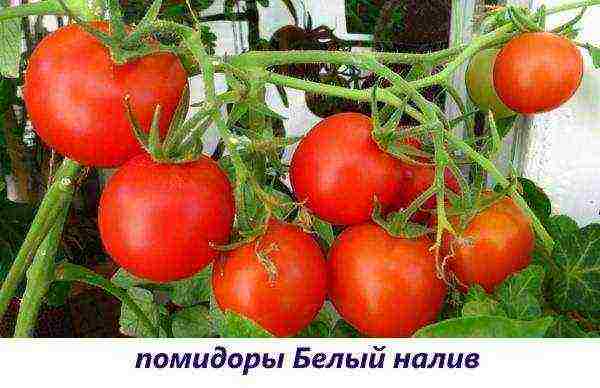
- Little Red Riding Hood. High-yielding variety up to 70 cm high with thick stems. Red-orange fruits weigh 70 g, the pulp is juicy, sweet and sour.
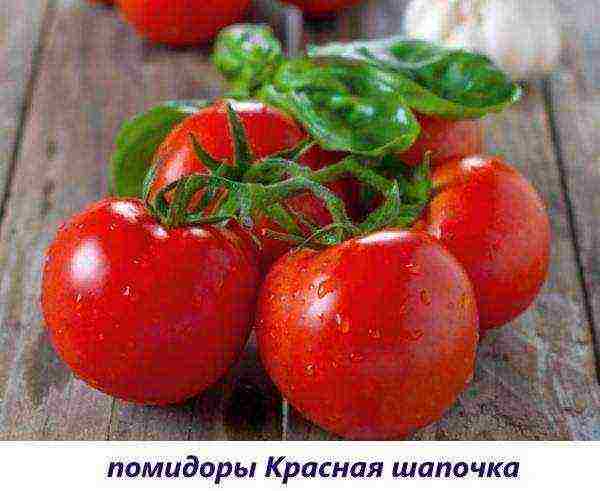
- Leopold. An ultra-ripe variety with a height of 70 cm. Fruits are dull red, weighing about 100 g.
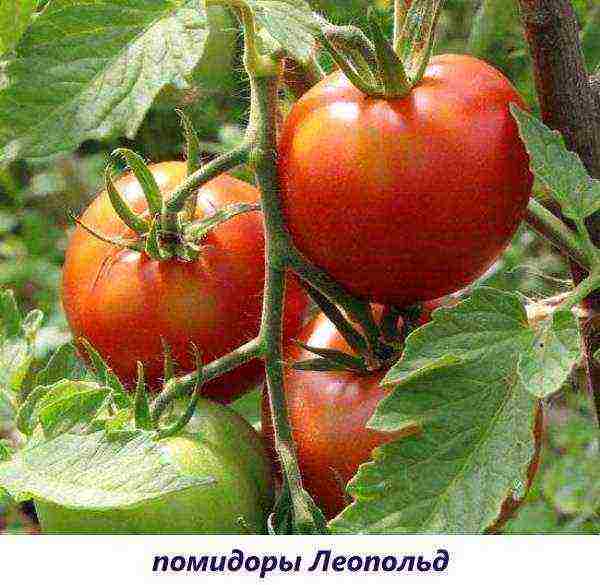
And in order to have fresh vegetables not only in spring, but also until the New Year, you can plant taller (up to 1 m in height) hybrid varieties of cherry tomatoes. On the windowsill, they will take up more space and require shaping and garters, but they will bear fruit before winter.
Some of the new, but already popular hybrids are such cherry varieties: Ira F1, Liza F1, Maxik F1, Likopa F1. Small but very tasty red or yellow tomatoes grow in whole clusters and ripen quickly.
For the summer period, it is better to take cherry pots to the street or to the balcony, not forgetting to take them to the house with a cold snap.
Growing a tomato on a windowsill is a fun activity that will not only help you while away the long winter days, but also provide your diet with vitamins.Plant and eat for health!
Video recommendations for growing tomatoes on a windowsill
Recently, growing tomatoes on the windowsill has become a popular activity among amateur gardeners. However, due to a lack of knowledge, it is not possible to harvest a good harvest: tomatoes are sick, grow poorly, or set few fruits. What conditions need to be provided for tomatoes in an apartment so that they bear fruit well at home?
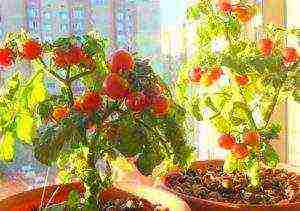
Features of growing tomatoes on a windowsill
The technology for growing miniature indoor tomatoes is very similar to the cultivation of ordinary tomatoes on the site. At the same time, there are several features that must be taken into account when deciding to acquire low-growing tomatoes in an apartment:
- for good fruiting, they need to be supplemented with phytolamps;
- in the room where the pots are located, you need to maintain a stable temperature and humidity;
- you cannot pour tomatoes, otherwise they will get sick with a black leg;
- growing containers must match the size of the plant;
- tomato flowers need to be pollinated on their own: during the flowering period, a soft brush is applied to the flowers 2-3 times a day.
Taking into account the specified nuances, which are described in detail below, the chance that growing tomatoes on a window in winter or at any other time of the year will be crowned with success at times.
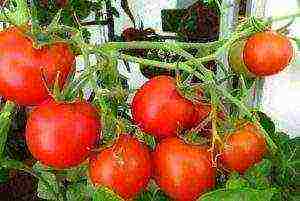
What varieties are suitable for growing on a windowsill
For growing in an apartment, it is better to choose determinant (undersized) varieties of tomatoes that do not need tying, are unpretentious to the composition of the soil and the length of daylight hours. Most varieties with such characteristics are standard hybrids. Depending on your wishes, you can plant super early or mid-season varieties. Such varieties of tomatoes as Bonsai, Balconnoe miracle, Pygmy, Pinnochio, Room surprise have excellent characteristics.
Despite the fact that the tomatoes of these varieties do not grow more than half a meter, the plants form about 2 kg of yellow or red fruits weighing from 15 to 100 g. Among the many tall varieties of tomatoes for growing on the windowsill, cherry tomatoes are suitable, which do not require special conditions.
How to plant and grow - features, conditions and step-by-step instructions
Growing tomatoes in an apartment is quite simple if the recommended requirements are followed exactly. Anyone who will take proper care of the plants will be able to enjoy bright juicy tomatoes in the middle of winter.
Video: how to grow tomatoes on a windowsill
What should be the place
To ensure that plants receive as much natural light as possible, tomatoes are best placed on south or east windows. If this is not possible, you can put the pots on the west window, but the culture will have to be supplemented. It is not recommended to grow light-loving tomatoes on northern windows.
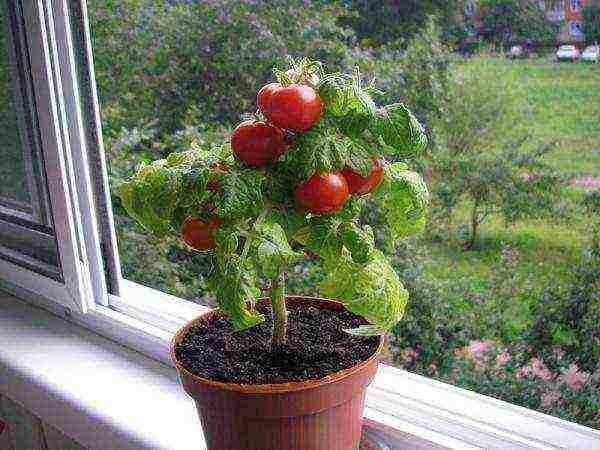
Temperature
When growing tomatoes on a window, it is very important to maintain the correct temperature regime. Deviations from the established ranges are fraught with slow development and poor productivity of the vegetable crop. When growing tomatoes on the window at home, you should adhere to the following recommendations:
- Seeds germinate quickly and amicably at a temperature of + 23- + 25 C.
- When the seedlings are 7 days old, the temperature is reduced to + 20- + 22 C. Being in colder conditions, the seedlings will not stretch out, which often happens with tomatoes in closed rooms. You can lower the temperature by airing the room for half an hour - the plant is not afraid of drafts.
- The optimum temperature at night is + 15- + 16C.
Important! On the coldest days, when the batteries get very hot, in order to protect the tomato leaves from the influence of warm air, the heating devices are covered with a wooden shield from above.
Humidity
It is necessary to spray tomatoes grown on the window only if the air in the room is very dry.When the temperature in the apartment is below +20 C, it is not at all possible to spray the plants: excessive humidity and cold air are the main reasons for the appearance of a black leg.
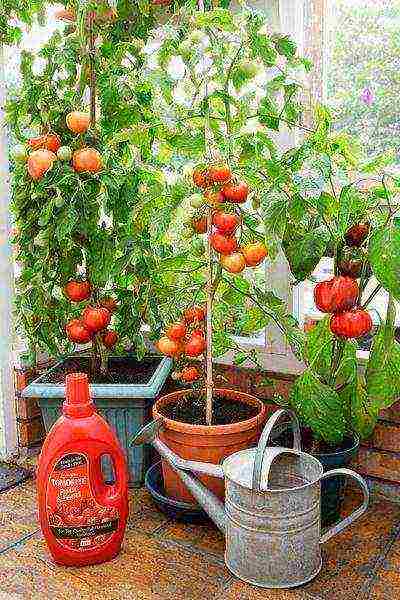
Lighting
Due to the fact that tomatoes are plants that need a long day of light in order to form many high-quality fruits at home, they need to be highlighted. The lamps turn on from 8 to 11 am and from 16 to 19 pm. The latest invented hybrids are unpretentious in the amount of light, however, for better productivity, it is even recommended to supplement them in the shortest days of winter.
Important! Indoor tomatoes can be grown without additional lighting from mid-February.
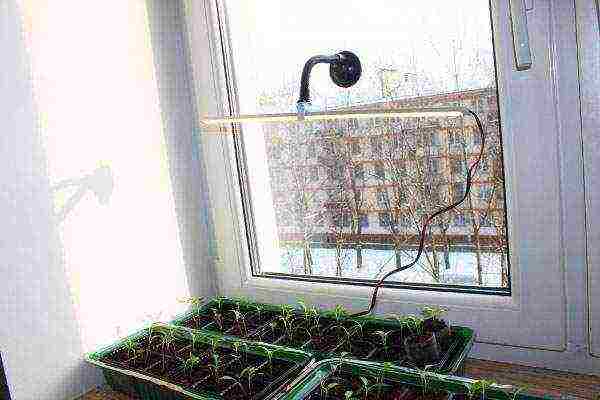
Despite the fact that tomatoes love to live on light windowsills, the leaves of young seedlings can get burned under the influence of bright spring rays. To protect the plant from such injuries, the pots are transferred to the east and north windows. If it is impossible to make such a rearrangement, in the brightest hours they are shaded with gauze or paper.
Tying and pinching
The vast majority of hybrids and varieties of tomatoes intended for growing in an apartment on a window or windowsill do not need to be tied up, since they are endowed with a low, powerful stem. Only some varieties, the height of which exceeds 50 cm, need support. Medium-sized tomatoes are formed into 2 stems, tall ones - into one.
What container to plant
Tomato seedlings are initially planted in seedling containers, and as soon as they become cramped, they are transplanted into separate peat pots or plastic cups with a volume of more than 200 ml. Using peat cups, you need to control the amount of watering, otherwise the containers may simply fall apart.
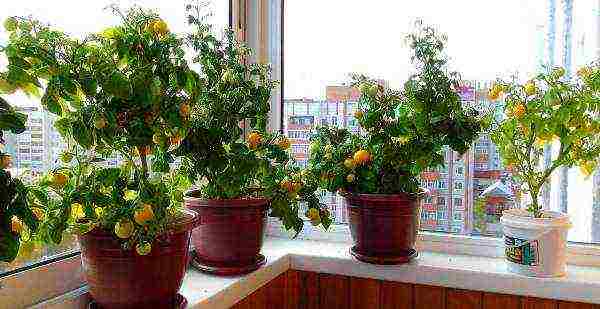
During the next transplant, when the plants have 4-5 pairs of true leaves, the tomatoes are planted in a permanent pot. The size of the planting container must be selected based on the characteristics of the cultivated variety: the more compact the plant, the smaller the planting container volume should be.
Based on this rule, for planting dwarf varieties, you need to use pots up to 2 liters. Indoor tomatoes are recommended to be planted in 3-4 liters containers, ampelous - in 5 liters. Regardless of the size, the bottom of the planting tanks should have drainage holes to drain excess water.
What soil to plant
For planting low-growing tomatoes in an apartment, use a special substrate of industrial production or a self-prepared mixture: mix garden soil, rotted compost and peat in a ratio of 5: 5: 2: 1. A potassium sulfate matchbox and about the same amount of urea are added to a bucket of potting soil. Pour a handful of wood ash into the mixture and mix thoroughly. The finished substrate is poured into a container and proceeds to planting.
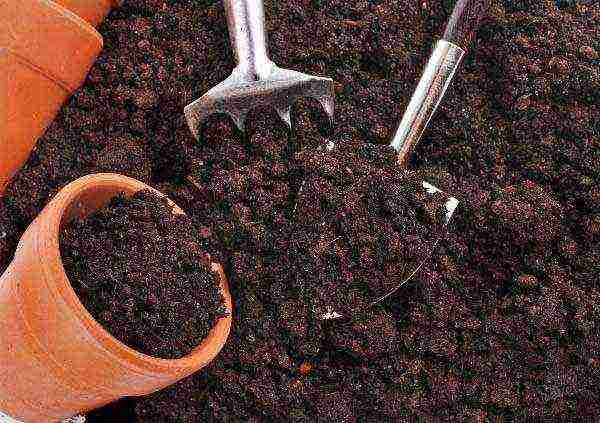
Important! Regardless of the origin, the soil must be calcined or frozen: high or low temperatures will destroy pathogenic bacteria and insect larvae. Moreover, in order to prevent tomato contamination with dangerous diseases, you need to calcine the tool that will be used when working with the soil at home.
Preparing seeds for planting
First of all, bad planting material is discarded. Seeds are poured into a container with salt water and mixed thoroughly. A few minutes after the water stops spinning, good seeds will sink to the bottom, and bad ones will remain on the surface. The floating seeds are drained along with the water, and the remaining ones continue to be prepared for planting in the apartment.
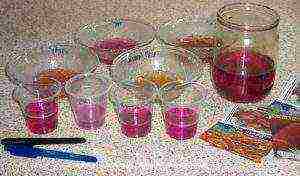
To destroy pathogens on the surface of seeds, planting material is soaked for 15-20 minutes in a weak solution of potassium permanganate. After the end of the time, they are taken out of the container and laid out on a paper towel. After drying, they are treated with a growth stimulant in accordance with the instructions.The substances contained in such preparations accelerate the germination of seedlings and increase the resistance of seedlings to diseases.
Direct landing
Indoor tomatoes are planted in the same way as ordinary ones, intended for growing in the open field. Landing is carried out in the following sequence:
- The disinfected planting material is laid out in a damp cloth and placed in a warm place so that they hatch. Please note that if the fabric dries out, it needs to be sprayed, otherwise the embryos will dry out and the seeds will not hatch.
- A prepared soil mixture or a special substrate is poured into the seedling container and grooves are made with a depth of 1 cm. It is not recommended to plant tomatoes at a depth of more than 2 cm: the seedling time is doubled. Seeds are laid out at a distance of 2-3 cm from each other.
- The crops are sprinkled with earth and slightly moistened. Until the emergence of shoots, the box is covered with film or glass, which are removed from time to time so that the soil does not become moldy.
- As soon as the seedlings throw out 2-3 pairs of true leaves, they are transplanted into pots of appropriate size, the bottom of which is laid with drainage material.
Video: how to grow indoor tomatoes in winter
How to care after planting and before harvest - tips
The health of tomatoes and the volume of the crop depend on the quality of care. In order for indoor tomatoes to develop quickly in an apartment and set the maximum number of fruits, they need to be watered and fertilized in a timely manner.
Watering
The soil in the pot must be slightly damp for the fruit to form and ripen. Tomatoes react poorly to both drought and overflow: in the first case, the fruits can be sprinkled during formation, in the second, the plant gets sick with a black leg, late blight.
Since chlorine is harmful to plants, you need to water indoor tomatoes only with well-settled water. In order for the particles of a chemical element to sink to the bottom, the water must be defended for a week. Using a filter, you can reduce the water preparation time to several hours. As soon as the soil dries out, the seedlings are watered moderately.
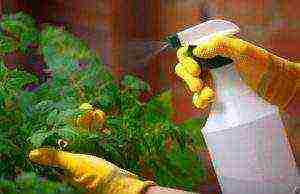
Subject to the temperature regime and normal air humidity, watering is carried out 1 time in 5 days. Out of turn, tomatoes are watered the day before transplanting: removing the rhizome from moist soil is much easier and less painful for the plant.
Top dressing
At the beginning of development, upon reaching the age of one week, indoor tomatoes in pots are fed with nitrogen fertilizers, which stimulate plant growth. During the setting of fruits and pouring them into the soil, potassium dressings are added.
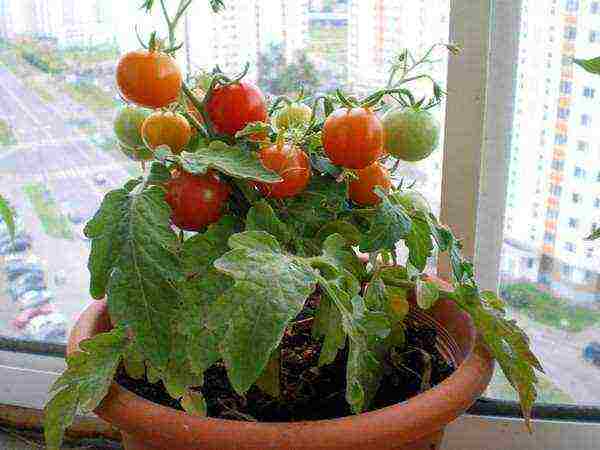
You can fertilize seedlings with ordinary mineral mixtures diluted in half with water. In order not to burn the roots, top dressing is applied 2 hours after watering. The optimal time for manipulation is cloudy weather. All types of fertilizers are applied no more than once every 2 weeks in accordance with the manufacturer's recommendations.
Worth knowing! For adult plants, fertilizing can be applied to the leaf or under the root. For young seedlings with delicate leaves, leaf feeding is contraindicated.
Terms of germination and harvesting
When the right conditions are created in the apartment, tomato seedlings appear on the surface 6-10 days after sowing. The germination time may be delayed if the room is too cold or the seeds are sown too deep. In such cases, seedlings begin to emerge only on the 14-17th day.
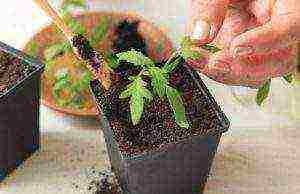
Window-grown tomatoes ripen 85-110 days after planting, depending on the variety selected.
Growing tomatoes on a windowsill is not only fun, but also a useful activity, thanks to which you can replenish the supply of vitamins for the whole family, which is especially important in winter.
Video: growing tomatoes on a windowsill
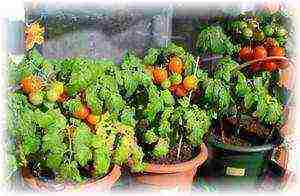 In winter, when a blizzard and cold are knocking on the window, fresh tomatoes on the windowsill seem to be something exotic, unattainable and only more attractive because of this.How realistic is it to grow them in a harsh season? If you know the small nuances of "potted farming", it is no more difficult than ordinary tomatoes in the beds. When there is an insulated balcony, tomato cultivation can be organized on it.
In winter, when a blizzard and cold are knocking on the window, fresh tomatoes on the windowsill seem to be something exotic, unattainable and only more attractive because of this.How realistic is it to grow them in a harsh season? If you know the small nuances of "potted farming", it is no more difficult than ordinary tomatoes in the beds. When there is an insulated balcony, tomato cultivation can be organized on it.
Varieties that will "get along" in the house
All "tomato work" is tightly linked to the availability of free space. If there is enough space on the balcony, you can choose almost any variety for planting - high, low, branched or not very. When only free space on the windowsill is available all year round, cherry varieties or miniature bushes specially bred for "home cultivation", which quickly "give away" the harvest, are suitable for cultivation. Among them there can be both red and yellow varieties of tomatoes. The qualitative composition does not depend on the external color.
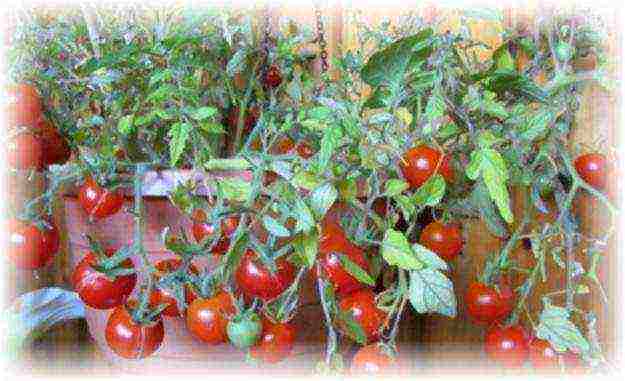 Cherry varieties: Bonsai, Balcony miracle, Baby, Balcony charm, Golden bunch, Chinese indoor, Indoor surprise, Rowan beads, Bullfinch, Japanese dwarf and others.
Cherry varieties: Bonsai, Balcony miracle, Baby, Balcony charm, Golden bunch, Chinese indoor, Indoor surprise, Rowan beads, Bullfinch, Japanese dwarf and others.
Common tomatoes that are suitable for a winter windowsill: White filling, Bull heart, Leopold, Siberian early ripening, Florida Petit, Yamal.
Tomato varieties for balcony cultivation can be taken slightly higher "in growth" and with larger fruits, otherwise the care for them will be the same as for vegetables on the windowsill.
It is important to check the expiration dates, which are always indicated on the original seed packaging. Often inexperienced vegetable growers cannot understand why their indoor tomatoes do not sprout in winter. It is quite possible that this is the result of an overdue implementation period.
Miracle on the balcony
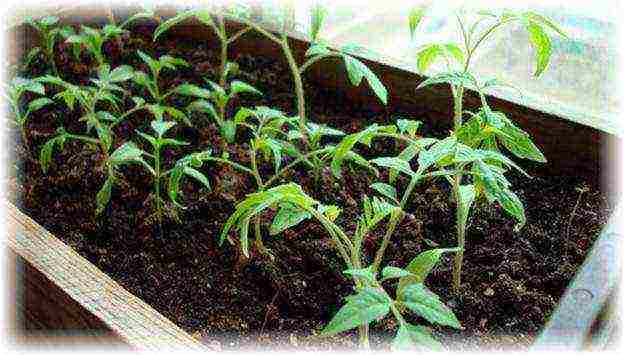 A special love of gardeners "at home" has won the "Balcony Miracle" tomato. This is a compact determinant variety, up to 50 cm high, ultra-early ripening (maximum ripening period of 90 days), the weight of each bright red tomato is up to 65 g, round in shape. The usual yield is up to 2 kg per bush. If the plant is "allocated" a large area, the yield in winter can be higher.
A special love of gardeners "at home" has won the "Balcony Miracle" tomato. This is a compact determinant variety, up to 50 cm high, ultra-early ripening (maximum ripening period of 90 days), the weight of each bright red tomato is up to 65 g, round in shape. The usual yield is up to 2 kg per bush. If the plant is "allocated" a large area, the yield in winter can be higher.
Before germination, the seeds are grown in greenhouse conditions, then the temperature is lowered for a week to 15 degrees, then raised again. When the sprouts rise to 15 cm, they dive into large containers. Tomatoes "Balconnoe Miracle" love light (although they ripen even in conditions of its deficit), do not require tying and removing stepchildren.
A positive effect during winter cultivation will be given: help in pollination, good watering, fertilization, gentle loosening of the soil, and the formation of a bush.
Feeding options:
- Special drugs.
- Liter solution: 5 g of superphosphate, mixed with potassium and urea sulfate - 1 g each.
The most productive top dressing in winter during flowering and fruit formation.
Growing a "Balcony Miracle" house will allow you to collect excellent tomatoes from the windowsill in winter for salads, preparations and even freezing.
Main growing conditions
Growing tomatoes on a balcony or windowsill requires compliance with a number of necessary conditions:
- The best location is at the southern windows. It is practically impossible - in the north.
- Decontaminated, non-clayey soil. Not less than 5 liters per bush.
- On the bottom - drainage with expanded clay or sand.
- Air humidity up to 65%.
- Daylight hours for seedlings are at least 12 hours even in winter, preferably 13-16.
- If necessary, supplement the illumination with lamps installed at least 30 cm from the seedlings.
- Water the tomatoes on the balcony or windowsill carefully, with warm water, without waterlogging, but also without overdrying. On average, every 3 days.
- Air temperature indicators: during the day 25-26 degrees, at night up to 15-16. If it's hotter - ventilate, tomatoes are not afraid of drafts.
- Do not grow on a balcony without insulation before April.
- Loosen the soil and top up if necessary.
- Spraying of leaves, garter of branches is possible.
- Do not turn the pots with bushes so that there is no dumping of tomatoes from the branches.
- It is advisable to install containers on rack supports.
You should not often fertilize tomatoes in winter with nitrogenous and organic fertilizers.Otherwise, powerful, rough bushes with a minimum of small fruits will grow.
Instructions for winter growing tomatoes on the windowsill
 Before you "start" the winter process of growing tomatoes at home, you need to stock up on all the necessary materials. "At hand" should be:
Before you "start" the winter process of growing tomatoes at home, you need to stock up on all the necessary materials. "At hand" should be:
- Seeds of well-known producers with a "fresh" shelf life.
- Sowing cups.
- Containers for planting after picking - "cut-off" bottles, pots.
- Lamps for supplementary lighting.
The main stages of work
- Preparation of containers and tools... "Fry" with a high temperature (in the oven) or treat with a preparation against fungi and bacteria. If new peat pots are used, soak them in a solution of mineral and organic fertilizers and dry them before planting.
- Land preparation. Tomatoes on the windowsill, as in outdoor cultivation, prefer "breathing", clean soil. Ordinary soil can be spilled with hot potassium permanganate, steamed in a water bath, or severely frozen. Examples of mixtures for self-preparation: on an equal part of the earth, humus, peat and sand; on two parts of the land, 4 "measures" of humus and peat, 1 - sand. It is good to spill with a mixture of urea and potassium sulfate, diluting a matchbox by 10 liters of water. Add a handful of ash there. The looseness of the soil is increased by peat or sawdust.
- Germination of seeds. To prevent late blight, soak them in a slightly pink solution of potassium permanganate for half an hour, dry and treat with a growth stimulant. For germination, "wet" the seeds with warm water and leave on a damp cloth in a warm place.
- Sowing rules for varieties for the balcony and windowsill. Sprouted tomato seeds are planted in lightly watered soil in small holes (up to 1 cm), 1 piece each. Dry ones are buried in 2 or 3 copies with a distance of 2 cm. Cover with a film on top or glass is laid and transferred to a warm place, but without "African hell". To harvest tomatoes on the windowsill in winter and early spring, sowing is carried out in October and late November. Continuity of picking tomatoes can be ensured with the following crops in mid-February and late March.
- "Moving" to a permanent place. When shoots have appeared, the covering material is removed, and the pots are rearranged closer to the window. Further, it is important to ensure that the sprouts have enough light and warmth in winter.
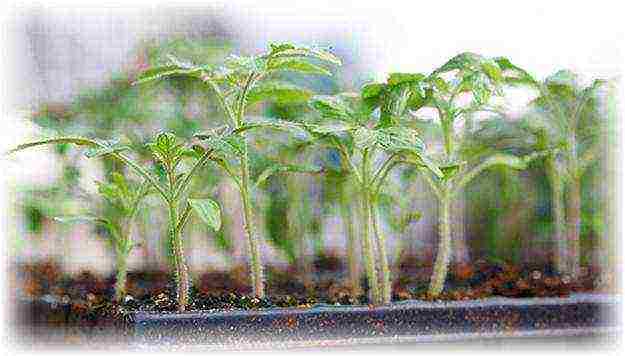 Lift containers with tomatoes from time to time to see if excess moisture has accumulated in the pan. It needs to be removed. Drizzle with water at room temperature.
Lift containers with tomatoes from time to time to see if excess moisture has accumulated in the pan. It needs to be removed. Drizzle with water at room temperature.
- Diving. During the appearance of 2 permanent leaves. After the "procedure" the strongest sprouts receive a more capacious "container" for growth - 7-10 liters. The roots of the seedlings are buried 3 cm, watered. Growing tomatoes on the balcony will take place in such large containers. Larger varieties are immediately tied to pegs. Any tomatoes in the winter after transplanting are not touched for about a week, so that the bushes calmly take root. When it's still cool outside, it is better to bring tomatoes from the balcony into the room at night. With the onset of heat, all landings "move" to the balcony.
- Winter feeding of tomatoes on the windowsill. Seedlings are "supplied" every 10 days with organic matter and ready-made mineral fertilizers. Follow the instructions on the package, remember to gently loosen the soil around the trunk. With the appearance of 2 true leaves, fertilize seedlings with a solution of trace elements in winter. The most important rules of work: for young plants, the dose, reduced by 2 times in comparison with the instructions, is carried out on wet soil, preferably without touching the leaves.
- Stealing and pruning. The stems that begin to grow from the axils of the leaves are called stepchildren. They are removed so as not to take food away from ripening fruits. For the formation of 2-3 stems in undersized varieties, you can leave the appropriate number of stepsons. The rest are removed by hand, preferably in the morning, while there is no strong sun.Low-growing and standard varieties can not be pinned, but the bush can not be thickened either. Sick and yellowed leaves are cut off. After the formation of the brushes, the lower leaves can also be cut off.
You cannot remove all the leaves. In this case, the synthesis of organic materials will be disrupted.
- Bush formation. After fruit setting, 4-5 brushes are left on each trunk. All others are removed along with the top of the stem and inflorescences. When the formation of the fruit itself begins, pinching the top and removing the flowering tassels is carried out.
- Pollination assistance. Tomatoes of "balcony" varieties are also self-pollinating, but help in winter will not hurt them. It is enough to lightly shake the brushes of flowers and tap on the stem. To prevent the ovary from falling off, it is permissible to spray the bush with a solution of boric acid - 1 g per 5 liters of water and add a little potassium permanganate.
- Disease prevention. Without proper care, tomatoes can get sick in winter when grown on a windowsill. If they are "flooded" - mold, rot or late blight are provided. For its prevention, a mixture of the following composition is well suited: half a glass of garlic and a little potassium permanganate (half a gram) are added to a three-liter container of water. Spraying with Fitosporin can be used. The appearance of the whitefly even during winter cultivation on the window is facilitated by soil acidification. The introduction of crumbs of chalk, ash, dolomite flour or slaked lime will help prevent acidity. There are also special deoxidizing preparations.
Responsibly caring for the bushes with all preventive measures, you can be sure that the tomatoes will ripen in the right amount.
Harvesting
In order to grow a full-fledged crop on the windowsill, it is important to harvest the fruits on time. In winter, the poured tomatoes are removed, which have begun to turn slightly pink. They are laid for ripening on a window or in a dark box. The process will go to the end, and the bush will "throw" all the released nutrients to grow the fruits remaining on the branches.
Knowing how to grow tomatoes at home on a windowsill or balcony, you can pamper your loved ones with “delicious plantings” not only in summer, but also in winter. This will especially delight children, who will examine each plant with the greatest curiosity and will certainly taste small tasty "tomatoes".


